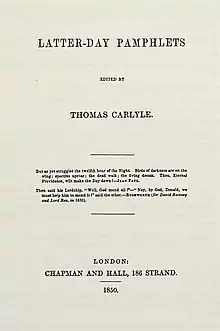Latter-Day Pamphlets
Latter-Day Pamphlets was a series of "pamphlets" published by Scottish essayist, historian and philosopher Thomas Carlyle in 1850,[1] in vehement denunciation of what he believed to be the political, social, and religious imbecilities and injustices of the period.[2]
 Title page of the first English book edition | |
| Author | Thomas Carlyle |
|---|---|
| Country | England |
| Language | English |
| Published | 1850 |
| Publisher | Chapman and Hall |
Overview
Carlyle called the Pamphlets "Carlylese 'Tracts for the Times,'" referring to the writings of John Henry Newman and the Oxford Movement. The comparison is apt, as Carlyle's polemical style and his search for an authoritative center of life share many similarities with the movement.[3] The Pamphlets are, at its core, a rebuke of democracy, "the grand, alarming, imminent, and indisputable Reality" of the time,[4] rooted in Carlyle's two basic principles of immutable order and eternal laws.[5] Carlyle conceived of the work as a sort of prose epic; though his original plan to produce twelve pamphlets – the number of books associated with such epics as the Aeneid and Paradise Lost – may have been coincidental, Carlyle's rhetoric echoes the epic form.[6] Carlyle announced the theme of his modern epic using the traditional epic question:
What is Democracy; this huge inevitable Product of the Destinies, which is everywhere the portion of our Europe in these latter days? There lies the question for us. Whence comes it, this universal big black Democracy; whither tends it; what is the meaning of it? A meaning it must have, or it would not be here. If we can find the right meaning of it, we may, wisely submitting or wisely resisting and controlling, still hope to live in the midst of it; if we cannot find the right meaning, if we find only the wrong or no meaning in it, to live will not be possible![7]
The best known of the essays in the collection is Hudson's Statue, an attack on plans to erect a monument to the bankrupted financier George Hudson, known as the "railway king".[8] The essay expresses central theme of the book — the corrosive effects of populist politics and of a culture driven by greed.[9] Carlyle also attacked the prison system,[10] which he believed to be too liberal, and democratic parliamentary government.
The imaginary figure of "Bobus", a corrupt sausage-maker turned politician first introduced in Past and Present, is used to epitomise the ways in which modern commercial culture saps the morality of society.
Contents
The essays[1] are:
- No. 1. The Present Time (1 February 1850)
- No. 2. Model Prisons (1 March 1850)
- No. 3. Downing Street (1 April 1850)
- No. 4. The New Downing Street (15 April 1850)
- No. 5. Stump-Orator (1 May 1850)
- No. 6. Parliaments (1 June 1850)
- No. 7. Hudson's Statue (1 July 1850)
- No. 8. Jesuitism (1 August 1850)
Reception and influence
.jpg.webp)
Reaction was fiercely divided. The first two essays, The Present Time (1 February 1850) and Model Prisons (1 March 1850) were reviewed by Karl Marx and Friedrich Engels in the Neue Rheinische Zeitung in April 1850.[11] Marx and Engels approve of Carlyle's criticisms against hereditary aristocracy; however, they harshly criticise Carlyle's views as "a thinly disguised acceptance of existing class rule" and an unjust exoneration of statism.[12] They rejected his hero-worship, called his commentary on class distinctions unhistorical, and condemned his doctrine of law-and-order as bourgeois hypocrisy. Marx would again attack Carlyle's "model prisons" and "aristocracy of talent" in two articles for the New York Daily Tribune, appearing 30 September and 19 October 1853 respectively. Anthony Trollope for his part considered that in the Pamphlets "the grain of sense is so smothered in a sack of the sheerest trash.... He has one idea – a hatred of spoken and acted falsehood; and on this, he harps through the whole eight pamphlets".[13] A century later, Northrop Frye would similarly speak of the work as "tantrum prose" and "rhetorical ectoplasm".[14]
In The Present Time, Carlyle criticized American democracy: "'What have they done?' . . . 'They have doubled their population every twenty years. They have begotten, with a rapidity beyond recorded example, Eighteen Millions of the greatest bores ever seen in this world before:—that, hitherto, is their feat in History!'—And so we leave them, for the present; and cannot predict the success of Democracy, on this side of the Atlantic, from their example."[15] This line provoked a reply from abolitionist Elizur Wright in the form of his own pamphlet, Perforations in the "Latter-Day Pamphlets" by One of the "Eighteen Millions of Bores"; it attacked Carlyle as ignorant and reactionary, concluding: ". . . we will take in good part the broad hint to make our calls shorter and less frequent at Cheyne Row."[16] Samuel Gray Ward later avoided a visit accordingly. Carlyle wrote to Ralph Waldo Emerson on 14 November 1850, "tho' Elizur sent me his Pamphlet, it is a fact that I have not read a word of it, nor shall ever read."[17]
Emerson expressed his appreciation of the work in a letter to Carlyle dated 5 August 1850. "The vivid daguerrotype of the times, the next ages will thank you for; but the circling baulking Present refuses to be helped."[18] Charles Dickens agreed with Carlyle's feeling, as expressed in Model Prisons, that criminals were being treated better than paupers. Dickens echoed Carlyle in an article entitled 'Pet Prisoners' which appeared in Household Words, a magazine edited by Dickens.[19] Carlyle's arguments against the attempt to "reform society through the exclusive mechanism of the ballot-box" impacted John Ruskin, John Stuart Mill, and Charles Kingsley, who equally denounced the folly of the "mere brute 'arithmocracy.'"[20] Professor H. J. C. Grierson regarded the Pamphlets as "central work" in Carlyle's œuvre.[21]
In his painting Work, inspired by the book, Ford Madox Brown depicted Carlyle watching honest workers improving the social infrastructure by laying modern drains in a suburb of London, while agents of the dishonest Bobus disfigure the area by marketing his political campaign with posters and sandwich boards.
Notes
- Carlyle, Thomas (1850). Latter-Day Pamphlets. London: Chapman & Hall.
-
 One or more of the preceding sentences incorporates text from a publication now in the public domain: Wood, James, ed. (1907). "Latter-Day Pamphlets". The Nuttall Encyclopædia. London and New York: Frederick Warne.
One or more of the preceding sentences incorporates text from a publication now in the public domain: Wood, James, ed. (1907). "Latter-Day Pamphlets". The Nuttall Encyclopædia. London and New York: Frederick Warne. - Goldberg, M. K.; Seigel, J. P., eds. (1983). Carlyle's Latter-Day Pamphlets. Canadian Federation for the Humanities/Fédération canadienne des études humaines. p. XLII. ISBN 0-920050-96-4.
- Carlyle, Thomas (1850). Latter-Day Pamphlets. The Works of Thomas Carlyle in Thirty Volumes. Vol. 20. New York: Charles Scribner's Sons (published 1903). p. 9.
- Goldberg, M. K.; Seigel, J. P., eds. (1983). Carlyle's Latter-Day Pamphlets. Canadian Federation for the Humanities/Fédération canadienne des études humaines. p. XXIX. ISBN 0-920050-96-4.
- Seigel, Jules P. (1976). "Latter-Day Pamphlets: The Near Failure of Form and Vision". In Fielding, K. J.; Tarr, Rodger L. (eds.). Carlyle: Past and Present. London: Vision Press. pp. 164–173.
- Carlyle, Thomas (1850). Latter-Day Pamphlets. The Works of Thomas Carlyle in Thirty Volumes. Vol. 20. New York: Charles Scribner's Sons (published 1903). pp. 9–10.
- Lambert, Richard Stanton (1934). The Railway King, 1800-1871. London: G. Allen & Unwin ltd.
- Cumming, Mark (2004). "Latter-Day Pamphlets." In: The Carlyle Encyclopedia. Fairleigh Dickinson University Press, p. 271.
- Seigel, Jules (1976). "Carlyle's Model Prison and Prisoners Identified," Victorian Periodicals Newsletter 9 (3), pp. 81–83.
- "Reviews from the Neue Rheinische Zeitung Politish-Ökonomische Revue No. 4" contained in the Collected Works of Karl Marx and Frederick Engels: Volume 10 (International Publishers: New York, 1978) pp. 301–310.
- "Reviews from the Neue Rheinische Zeitung Politisch-Ökonomische Revue No. 4" contained in the Collected Works of Karl Marx and Frederick Engels: Volume 10, p. 306.
- Quoted in M. Sadleir, Trollope (London, 1945), p. 158.
- N. Frye, Anatomy of Criticism (Princeton, 1971), pp. 21 and 325.
- Carlyle's Latter-Day Pamphlets. Ed. Michael K. Goldberg and Jules P. Seigel. Ottawa: Canadian Federation for the Humanities, 1983. p. 28.
- The Correspondence of Emerson and Carlyle. Ed. Joseph Slater. New York: Columbia University Press, 1964. p. 463n.
- The Correspondence of Emerson and Carlyle. Ed. Joseph Slater. New York: Columbia University Press, 1964. p. 464.
- The Correspondence of Emerson and Carlyle. Ed. Joseph Slater. New York: Columbia University Press, 1964. p. 461.
- Dickens, Charles (27 April 1850). "Pet Prisoners". Household Words. Vol. I. London. pp. 97–103.
{{cite book}}: CS1 maint: date and year (link) - Kingsley, Charles (1854). "Preface". Alton Locke. London: J. M. Dent (published 1910). p. 19.
- Goldberg, M. K.; Seigel, J. P., eds. (1983). Carlyle's Latter-Day Pamphlets. Canadian Federation for the Humanities/Fédération canadienne des études humaines. p. XIII. ISBN 0-920050-96-4.
Further reading
- Frye, Lowell T. (2012). "'This Offensive and Alarming Set of Pamphlets': Thomas Carlyle’s Latter-Day Pamphlets and the Condition of England in 1850," Studies in the Literary Imagination 45 (1), pp. 113–138.